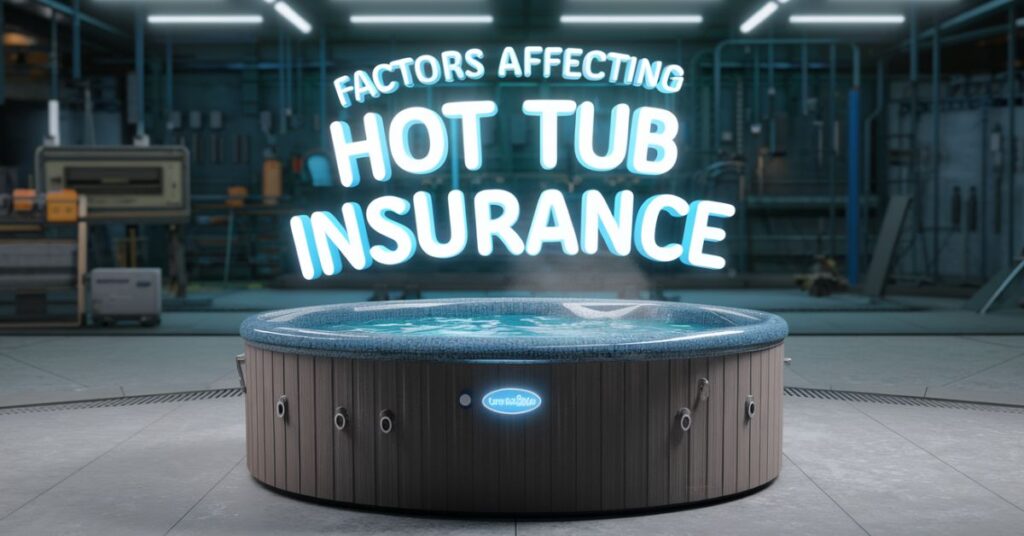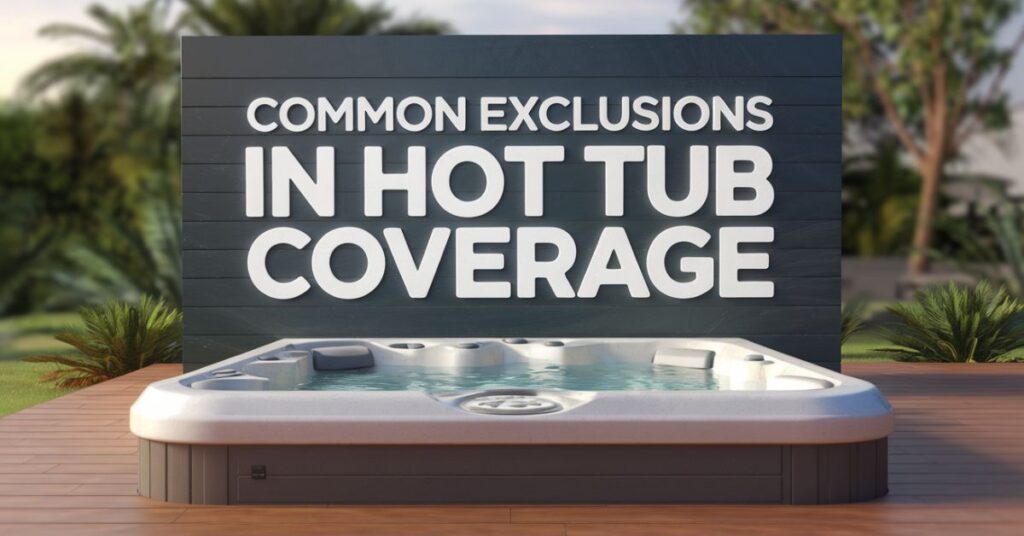Hot tubs are fun backyard additions, but they can be expensive. Many homeowners wonder if their insurance will protect this investment if something goes wrong.
Imagine coming home to find your hot tub damaged by a fallen tree. Or picture a guest slipping and getting hurt near your tub. These situations can happen to any hot tub owner. But are you protected? Let’s dive into the world of hot tub insurance.
This article will explore hot tub coverage in home insurance. We’ll look at what’s typically covered and what’s not. We’ll also discuss how to protect your hot tub investment. Let’s dive in and learn more about this topic.
Hot Tubs and Standard Home Insurance Policies
Home insurance policies vary widely. Some may cover hot tubs, while others may not. It’s important to understand your specific policy. Most standard policies don’t automatically include hot tub coverage.
Many insurers see hot tubs as a separate structure. They might treat it like a shed or detached garage. This means it may need additional coverage. Some policies might offer limited coverage for hot tubs.
It’s crucial to talk to your insurance agent. They can explain your policy’s details. They can also help you understand any gaps in coverage. Don’t assume your hot tub is fully protected without checking.
Risks Associated with Hot Tubs
Hot tubs come with several risks. Understanding these can help you see why insurance is important. Water damage is a major concern. A leak could damage your home’s structure or belongings.
Injuries are another risk. Someone could slip and fall near the hot tub. Or they might get hurt while using it. These accidents could lead to liability claims against you. This is why liability coverage is crucial.
Theft or vandalism can also happen. Hot tubs are valuable and might attract thieves. Weather damage is another possibility. Storms or falling trees could damage your hot tub. Knowing these risks helps in choosing the right coverage.
Types of Coverage for Hot Tubs
There are different ways to ensure a hot tub. Here’s a brief overview:
- Standard home insurance: May offer limited coverage
- Endorsements: Add-ons to your existing policy for better protection
- Umbrella policies: Provide extra liability coverage
- Separate policy: Specific insurance just for your hot tub
- Personal property coverage: May cover portable hot tubs
Factors Affecting Hot Tub Insurance

Many things can affect your hot tub insurance. The location of your hot tub is important. Indoor tubs might be covered differently than outdoor ones. The type and value of your hot tub also matter.
Safety measures play a big role too. Having proper fencing and covers can help. Regular maintenance is also key. Insurance companies like to see that you take good care of your hot tub.
Location of the Hot Tub
Where you place your hot tub matters. Indoor hot tubs might be covered differently than outdoor ones. Some policies cover hot tubs inside the home under personal property. Outdoor hot tubs might need separate coverage.
Hot tubs on decks or patios have unique concerns. The added weight could damage the structure. This might affect your insurance needs. Always inform your insurer about your hot tub’s location.
Type and Value of the Hot Tub
The type of hot tub you own affects coverage. Portable hot tubs might be covered as personal property. Built-in hot tubs often need different insurance. The value of your hot tub is also important.
Expensive hot tubs might exceed standard coverage limits. You might need additional coverage for high-value tubs. Some insurers offer special policies for luxury hot tubs. Always know your hot tub’s value when talking to insurers.
Safety Measures in Place
Safety features can affect your insurance. Proper fencing around the hot tub is often required. Covers and locks can also be important. These features may lower your insurance costs.
Good maintenance is another safety measure. Regularly cleaning and checking your hot tub helps. It can prevent accidents and damage. Some insurers might offer discounts for good maintenance.
Read this Blog: Insurance Policy Covers Business During the Restoration Period
Common Exclusions in Hot Tub Coverage

Most policies have limits on what they cover.
There are some common exclusions:
- Wear and tear: Normal aging isn’t usually covered
- Poor maintenance: Damage from neglect is often excluded
- Manufacturing defects: These might be covered by warranty, not insurance
- Intentional damage: If you damage your hot tub on purpose, it’s not covered
- Certain natural disasters: Some events like earthquakes might be excluded
How to Ensure Proper Coverage for Your Hot Tub
To get the right coverage, start by checking your current policy. Look for any mentions of hot tubs or similar structures. If you’re not sure, ask your insurance agent for help. They can explain what’s covered and what’s not.
Consider getting extra coverage if needed. This might mean adding an endorsement to your policy. Or you might need a separate policy just for your hot tub. Don’t forget about liability coverage too. It’s important in case someone gets hurt.
Review Your Current Policy
Start by looking at your existing insurance. Read through your policy carefully. Look for any mentions of hot tubs or similar structures. If you’re unsure, mark those sections to ask about later.
Don’t hesitate to ask questions. Your insurance agent is there to help. They can explain any confusing terms or clauses. They might also spot coverage gaps you missed.
Consult with Your Insurance Provider
Set up a meeting with your insurance agent. Tell them about your hot tub plans. Ask how it affects your current coverage. They can explain your options for protecting the hot tub.
Be prepared with questions. Ask about liability coverage limits. Inquire about any safety requirements. Discuss the cost of adding hot tub coverage. Your agent can help you make informed decisions.
Consider Additional Coverage Options
Think about extra protection for your hot tub. An umbrella policy might be a good choice. It adds more liability coverage. This can be crucial for hot tub owners.
Endorsements are another option to consider. These add specific coverage to your policy. They can fill gaps in your standard coverage. Ask your agent about available endorsements for hot tubs.
Implement Safety Measures
Safety measures can help in many ways. They reduce accident risks. This can lower your insurance costs. It also protects you and your guests.
Install proper fencing around your hot tub. Use a locked cover when it’s not in use. Keep the area around the hot tub clear. Regular maintenance is also a safety measure. Well-maintained hot tubs are less likely to cause problems.
Document Your Hot Tub
Keep records of your hot tub. Save the purchase receipt and warranty information. Take photos of the hot tub and its surroundings. Document any safety features you’ve installed.
This documentation serves multiple purposes. It helps if you need to make a claim. It can also be useful when discussing coverage with your insurer. Good records show you’re a responsible hot tub owner.
Cost Implications of Insuring a Hot Tub
Adding a hot tub can affect your insurance costs. The exact impact varies by insurer and situation. Generally, you might see a small increase in premiums. This is because of the added risk.
The cost increase depends on several factors. The value of your hot tub matters. Higher-value tubs might cost more to insure. Your location also plays a role. Areas prone to certain risks might have higher rates.
Safety measures can help control costs. Good security and maintenance might lower premiums. Some insurers offer discounts for safety features. Ask your agent about ways to minimize cost increases.
Making a Claim for Hot Tub Damage

If your hot tub gets damaged, act fast. Contact your insurance company right away. They’ll tell you what to do next. Take photos of the damage and keep any receipts for repairs.
Be ready to answer questions about what happened. Your insurer might send someone to look at the damage. They’ll review your claim and decide what’s covered. Keep in touch with your agent throughout the process. They can help if you have any problems or questions.
Steps to File a Claim
If your hot tub is damaged, act quickly. Contact your insurance company right away. They’ll guide you through the claim process. Be ready to provide details about the damage.
Document everything carefully. Take photos of the damage. Keep receipts for any emergency repairs. Your insurer might send an adjuster to inspect the damage. Be available to meet with them and answer questions.
What to Expect During the Claims Process
The claims process can take time. Your insurer will review your claim carefully. They’ll look at your coverage and the damage details. Be patient and stay in communication with your agent.
You might need to get repair estimates. Your insurer could have preferred providers. They’ll explain what they need from you. Keep records of all communications during this process.
Potential Outcomes of a Claim
Claims can have different outcomes. Your insurer might approve full coverage for repairs. They could offer partial coverage based on your policy. In some cases, they might deny the claim.
If your claim is approved, you’ll receive payment. This might be directly to you or to the repair company. If denied, ask for a detailed explanation. You may have the option to appeal the decision.
Preventive Measures and Maintenance
Regular maintenance is key for hot tubs. It helps prevent damage and accidents. Clean your hot tub regularly. Check water chemistry often. This keeps the water safe and protects the tub.
Inspect your hot tub periodically. Look for signs of wear or damage. Fix small issues before they become big problems. This can prevent costly repairs later.
Use a cover when the hot tub isn’t in use. This protects it from debris and weather. It also helps maintain water temperature. Proper winterization is important in cold climates. Follow manufacturer guidelines for seasonal care.
Legal Considerations for Hot Tub Owners
Hot tub ownership comes with legal responsibilities. You must ensure safety for users. This includes proper fencing and signage. Failure to do so could lead to liability issues.
Be aware of local regulations. Some areas have specific rules for hot tubs. These might include safety standards or permit requirements. Comply with all local laws to avoid problems.
Consider the impact on neighbors. Noise and privacy can be concerns. Be considerate in your hot tub use and placement. Good neighbor relations can prevent legal disputes.
Hot Tub Insurance vs. Warranty
Insurance and warranties serve different purposes. Insurance protects against unexpected events. This includes accidents, theft, or natural disasters. Warranties cover defects or failures in the hot tub itself.
Warranties usually have time limits. They might cover parts and labor for a set period. After that, you’re responsible for repairs. Insurance, on the other hand, continues as long as you pay premiums.
Don’t rely solely on warranties for protection. They won’t cover many types of damage. A combination of warranty and insurance offers the best protection. Understand the limits of each to ensure full coverage.
Tips for New Hot Tub Owners
New hot tub owners should consider several things:
- Research insurance options before buying a hot tub
- Install proper safety features from the start
- Learn about proper maintenance and care
- Understand local regulations and comply with them
- Consider the long-term costs, including insurance and maintenance
Future Trends in Hot Tub Insurance

Insurance for hot tubs may change over time. More insurers might offer specialized coverage. This could make it easier to protect your investment. Technology could play a role in future policies.
Smart hot tubs with safety features might get better rates. Insurers might use data from these tubs to assess risk. This could lead to more personalized policies. Climate change might also affect hot tub insurance.
Areas with increased weather risks might see changes. Policies might adapt to new environmental challenges. Stay informed about insurance trends to protect your hot tub long-term.
Final Words
Hot tub coverage in home insurance is complex. Standard policies often don’t provide full protection. It’s crucial to review your policy and talk to your insurer. Additional coverage might be necessary for proper protection.
Understanding the risks associated with hot tubs is important. This knowledge helps in choosing the right insurance. Safety measures and regular maintenance are key. They can prevent accidents and may lower insurance costs.
Remember, every situation is unique. What works for one hot tub owner might not work for another. Always consult with insurance professionals for personalized advice. With the right coverage and care, you can enjoy your hot tub with peace of mind.
Frequently Asked Questions
Does standard home insurance cover hot tubs?
Not always; check your policy or ask your agent for details.
What types of damage are typically covered for hot tubs?
Often covers theft, vandalism, and some natural disasters, but varies by policy.
Do I need extra liability coverage for my hot tub?
It’s often recommended due to increased accident risks.
Can safety features lower my hot tub insurance costs?
Yes, many insurers offer discounts for safety measures.
Should I inform my insurer before installing a hot tub?
Yes, always notify your insurer about significant property changes.

David: Seasoned financial expert with 5 years in banking and investments.
Skilled in personal finance, market analysis, and wealth management. Empowers clients to achieve financial goals.





